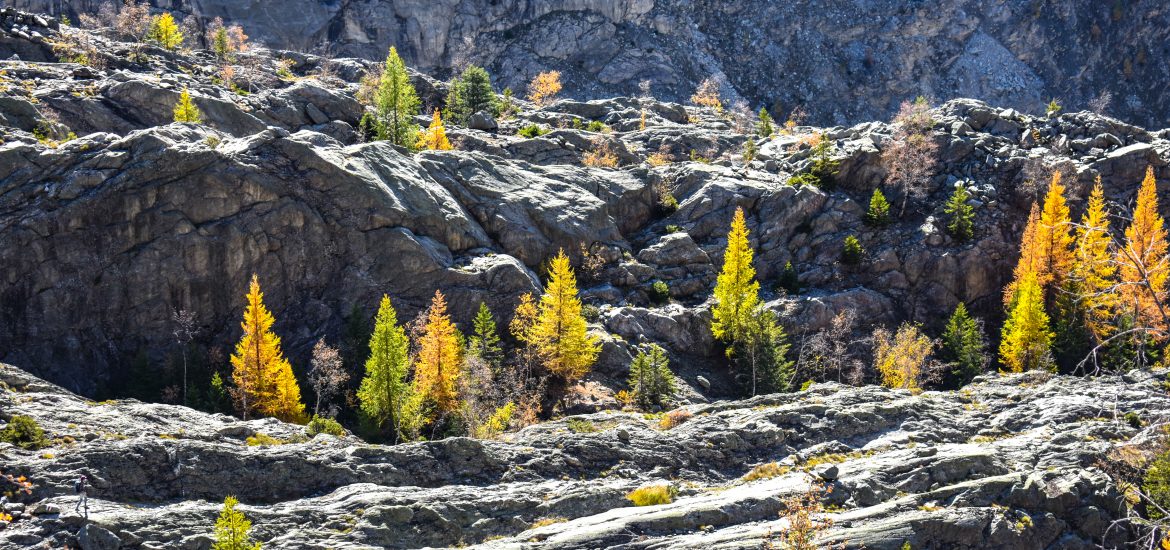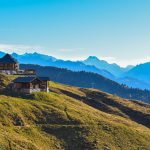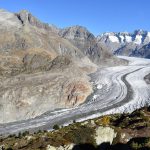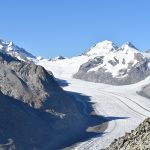Following the first post about the UNESCO Panorama Path from Belalp to Riederalp, this post will continue introducing to you the highlights including the the “färricha” and “Zickzackweg“, Aletschji, the suspension bridge (Hängebrücke), Grünsee (the Green Lake), Aletsch forest and Pro Nature Center Aletsch (Villa Cassel).
3.4 Evidence of traditional farming such as “Färricha” and the “Zickzackweg”





Along the way from Belalp cable car station to Hotel Belalp, to Aletschji and to the suspension bridge, you will see many farmhouses, pastures and sometimes just simple huts. This is because typical mountain farms in Valais are made up of land around the farmhouses, spring pastures at medium altitude and summer pastures at higher altitude in the Alps. The reason why the local farmers are called “nomads of the vertical” is that traditional farming here involves a considerable difference in altitude between the main farms and the different pastures. Farmers as well as their livestock need to move in different seasons to different altitudes and nowadays what’s especially interesting to tourists are the “färricha” (please note that the “färricha” is located on your way before you reach Hotel Belalp, you will see the signposts telling you where it is as shown in the second pic above) and the “Zickzackweg“. In order to understand these two words, it is necessary to know what the “Sheep and Shepherds’ Sunday” is. Over the year, the sheep are kept at different altitudes. For example, from November to April, they are mostly kept indoors. From April to mid-May they are let out in the spring pastures and from mid-May on, they will be taken up to the lower mountain pastures. About a month later they will be taken even higher to the real summer pastures and they will stay there till the end of August. By the end of August, when the weather gets colder and colder, they will be gathered together and prepared to return to the valley. On the Saturday before the “Sheep and Shepherds’ Sunday”, they will finally arrive at the Aletschbord from the Tälli hut after walking for about 10 hours. I experienced the hiking path including the “Zickzackweg” and I can understand how tiring it is for the sheep to travel such a long journey. When you are traveling, be careful with the sand and small stones because they can make this path rather slippery. Can you imagine what a spectacular view it would be when hundreds of sheep are on the “Zickzackweg” path (As shown in the forth picture in this section)? Next day, the sheep are separated into “färricha” to be assigned to their owners, which marks the highlight of the shepherd’s year. Nowadays, this Sunday has become more of a tourist attraction but the original characteristic has been kept. Next year I’ll try my best to plan another visit to Belalp and I hope I’ll be lucky enough to see this special event.
By the way, have you heard about the legend of the old Schmidja? I assume that you would be traveling in day time so the story would be interesting. However, if somehow you plan to travel at night, I must warn you that it can be a bit scary. The story is mainly between the widow, old Schmidja, who was living in the Alestch Valley and the poor dead souls of the Aletsch glacier. It is said that every night before she went to bed she would light a lamp for the dead souls to get warm and they would leave in the morning before the bells rang for morning prayers. The moment the old widow died, the watcher said that there was a long march of lights moving towards the glacier and they were the dead souls, on their way to accompany their old friend, with the lamps that old Schmidja left burning for them. If you like the story and wanna learn more about it I suggest you visit the exhibition “Faszination Aletschgletscher”close to the Bergstation Bettmerhorn and old Schmidja will “be there telling” you the whole story by herself.
Can you please scroll up a bit and take a look at the fifth picture in this section? It is a chapel that I noticed on my way to the suspension bridge and I went inside to have a look. It was built more than 100 years ago and in it there seemed to be several “books” recording all the residents who lived or are living here in this valley. It was rather interesting to me because I’ve never seen anything like this in any other chapels or churches. If you are interested you can also go in and take a look. In the next section, I’m gonna take you to learn about the history of the great Aletsch glacier told by the traces left behind during its “activities”.
3.5 What the great Aletsch glacier has done to this valley




Do you know that during the last glacial period around 24,000 years ago, all of Valais was covered by ice? The ends of this huge ice shield even reached today’s region of Solothurn and as far as Lyon in France! In this region only the highest peaks such as the Finsteraarhorn, Aletschhorn, Eggishorn, Bettmerhorn, Bietschhorn and Sparrhorn stood out and the ice cap between Fiesch and Brig was between 1400-1500 meters thick! As I mentioned above, the glacier doesn’t just rest and wait for getting bigger or smaller. It’s in constant flow. The glaciers grand, eroded, leveled and gave the landscape its permanent shape. For example, the traces of the last glacial period can still be observed today at the upper limit of Hohstock’s vertical walls above Belalp. If you’ve been to the viewpoints of Moosfluh or Bettmerhorn, you will be able to see the rock that the great Aletsch glacier deposited during the last glaciation period as well as the basins that it eroded that have already turned to be the Blausee lake and Bettmersee lake. When I was on my way to the suspension bridge and walking on the rocks, my friend told me the strange shapes and uneven surface of them are also the work of the moving glacier. I can’t say it’s absolutely true but the surface does seem like having been engraved by some mighty flowing object.
Fortunately, as the weather got warmer and warmer, the huge glacier started to disintegrate. Around 11,700 years ago, a significant warming period put an end to the Ice Age. However, don’t misinterpret this phenomenon as since then the glacier kept getting shorter and shorter till nowadays. The fact is that since then the cold and warm times alternated irregularly and some of the cold periods also led to the advance of the glacier. For example, as I read from the brochure called “Ice streams in the Aletsch region”, it says:
The result is a complete graph of the advance and retreat periods of the last 3500 years. Seven advance periods are documented. Very obvious are the maxima during the Little Ice Age: shortly after 1369, around 1678 and between 1859 and 1860. There were also periods during which the Great Aletsch glacier was the same size as today’s, particularly during the climatic optimum in the Middle Ages between 800 and 950 AD. In the Late Bronze Age, between 1350 and 1250 BC, the Great Aletsch Glacier was roughly one kilometer shorter than today. During the Iron Age and the Roman Age the Great Aletsch was a tiny bit shorter than nowadays. The still retreating glacier has lost approximately 4 km of its length since the beginning of the retreat’s period in 1860/1865.
I was indeed surprised when I learnt that several thousand years ago the glacier was even shorter than today’s. This research result did break my stereotype of the movement of the glacier as well as the definition of climate change. Nevertheless, what evidence was left behind concerning the retreat and advance of the Aletsch glacier? First of all, gigantic moraines can still partially be seen below Hotel Belalp in Holzji. Secondly, as you walk down from Aletschbord to the suspension bridge, you will be on the mountain pastures called “Aletschji”, where the vegetation, soil and particularly broken trees will tell you the “activities” of the glacier. When the glacier advanced, they were buried under the ice and moraine debris. Protected by solid rocks, once the glacier retreated, they came to see the sun again. This situation reminds me of several other UNESCO World Heritage sites in Switzerland called “Prehistoric Pile Dwellings around the Alps”, where organic materials such as tree trunks and wastes left over by mankind are kept and preserved under water. The same technologies, such as carbon-14 dating and tree-ring analysis (dendrochronology) have been applied to the trees here in Aletschji as well in determining the times of the glacier’s advance, thus providing essential information for studying the climate’s history. Therefore, while you hike on this path and see the broken tree trunks here and there, some of them might actually be fossils, dating back even to the Bronze Age! (I doubt that scientists would still leave these fossils on the field but for the tree trunks dating back to the Middle Ages or New Age I believe you can still see them.) Finally, after hiking on the Aletschji mountain pastures, you will be at the middle “station”, the suspension bridge.
3.6 The suspension bridge



The suspension bridge is undoubtedly on of the most popular attractions in this region. However, due to the difficult access to it, it’s not crowded at all. First of all, let’s know some statistics about it.
- Total length: 124 m
- Maximum sag: 8 m
- Width: 1 m
- Height: 80 m
- First opened: 2008
As I mentioned before, in old times it was possible to cross the glacier to reach either side of the valley. However, recently, the retreat of the glacier has made this impossible. Thanks to the cooperation of Pro Natura, WWF and UNESCO World Heritage Site Swiss Alps Jungfrau-Aletsch, the suspension bridge was constructed and opened in 2008 to restore the link between the two old villages. Can you imagine the experience of walking on a 124 m long bridge hanging 80 m above the roaring ice-cold glacier water stream? I’m afraid of height but fortunately when I was on the bridge the wind was not strong and it was only swinging a little bit back and forth. However, no matter how scaring or challenging it was to cross the bridge, it was of vital importance for me because if I wanted to look at the full picture of the Aletsch glacier I had to be here and watch the snout of it, where the glacier ices turns into glacier water and flows to the Stausee. In my opinion, the big rocks on either side of the bridge could be an ideal place for taking a rest or having some light meals, but don’t forget to take the trash away with you because now we’ve entered the Aletsch Nature Reserve.
3.7 Aletsch Nature Reserve (Aletsch forest and the Grünsee lake)
You will basically spend the second half of your journey here in this nature reserve and it was placed under protection by Pro Natura in 1933. Since then the whole forest has been left to itself and the fallen trees are just part of it. Please note that under cantonal law, the following rules apply:
- do not leave the marked paths
- dogs must be kept on leash
- do not make fire int he protected area
- take your trash away with you
- vehicles are not permitted (including mountain bikes)
Here you will not only see the unique larches but also the stone pines which grow on cliffs or dead woods. It is also here that you will not only see the oldest trees in Switzerland but with a bit of luck, also encounter (in the early morning or late afternoon) some of the wild animals such as spotted nutcrackers, black grouses, chamois or even red deer. I heard the birds singing but unfortunately I wasn’t lucky enough to “meet” the “residents” here.
As translated from the information brochure called “Forêt d’Aletsch: bientôt une forêt vierge!” published by Pro Natura, there are some facts about the Alestch forest that you should know:
- Two species of trees bear particularly well the difficult climate that reigns in the Aletsch forest: the pines and the larches.
- The pines grow very slowly, a few centimeters per year to the maximum. On the other hand, they can become thousand years old. Have you noticed the twisted and gnarled trunks of the trees? This system of twisted growth gives the pines great stability and contributes to their impressive resistance.
- Since 1933, the forest of Aletsch has been protected from all exploitation. Fallen trees are left in place. They serve as substratum for many living beings. For example fungus, lichens, mosses, dwarf shrubs and even seeds of pines germinate on these dead woods.
- The Aletsch forest was “planted” by the speckled nutcrackers. These birds, in fact, are extremely fond of the seeds of pines. They make reserves for the winter, which they hide and later manage to find, even under a meter of snow! As the speckled nutcrackers do not consume all the seeds they hide, unused reserves eventually germinate and give rise to new pines.
- The red deer only stay in the Aletsch forest in summer. However, numerous deer strike against so many young trees that they threaten the natural rejuvenation of the forest. In autumn, the wildlife department proceeds with the targeted deer slaughter to ensure that the population is better distributed and that the young trees can continue to grow.
- The retreat of the Aletsch glacier causes a loss of stability of the slope between Moosfluh and the edge of the glacier, and the terrain begins to slide downwards. This phenomenon, which has been observed for several years, accelerated considerably in the autumn of 2016. Therefore, the hiking trails in relevant area had to be closed and it is now forbidden to enter. It is unlikely that any the terrain will suddenly sink, but it’s better to be safe and sure. Nearly two thirds of the forbidden area is within the Aletsch Forest Nature Reserve. On the other hand, for nature, this closed zone provides an opportunity to develop without the disturbance of human activities.
When I was hiking in this forest with my friend, she told me that compared to running, swimming or some other sorts of exercises, simply walking in a forest proves to be the healthiest. It’s not only because of the fresh air or oxygen but also because of certain kinds of oil that the trees distribute and after inhaling them, they are beneficial both physically and mentally. I’m not sure about the scientific arguments behind this conclusion but I did feel relaxed and refreshing after going through the Aletsch forest.





Did you notice that the first gallery I attached above is about the small flora in this forest? Reminded by my friend, I noticed them between the rocks and if you don’t pay attention it’s really easy to neglect them. At that point I was asking myself, why going to the Alpine Garden to look for them while you yourself are in the Alps already?
Now let’s come back to the forest. Having looked at the pictures above, what are you thinking of at this moment? I was there in the autumn of 2017 and I was indeed astonished by the work of nature. Each brush of wind adds a thin layer of different colors to the trees and only the master painter possesses this skill and magic power. Actually, a song was being played all the time in my ears while I was hiking in the Aletsch forest. What song? Have you ever heard of “Colors of the Wind” by Vanessa Williams?
You think you own whatever land you land on
The earth is just a dead thing you can claim
But I know every rock and tree and creature
Has a life, has a spirit, has a name
…
Have you ever heard the wolf cry to the blue corn moon
Or asked the grinning bobcat why he grinned?
Can you sing with all the voices of the mountain?
Can you paint with all the colors of the wind?
…
Come run the hidden pine trails of the forest
Come taste the sun-sweet berries of the earth
Come roll in all the riches all around you
And for once, never wonder what they’re worth
The rainstorm and the river are my brothers
The heron and the otter are my friends
And we are all connected to each other,
In a circle, in a hoop that never ends
Have you ever heard the wolf cry to the blue corn moon
Or let the eagle tell you where he’s been
…
How high does the sycamore grow?
If you cut it down, then you’ll never know
…
We need to sing with all the voices of the mountain
Need to paint with all the colors of the wind
You can own the earth and still
All you’ll own is earth until
You can paint with all the colors of the wind
Isn’t this the best song for describing the beauty of the autumn Aletsch forest and for raising people’s awareness of protecting and treasuring it? If you are interested in exploring the forest even more deeply, I suggest you visit the official website of Pro Natura Center Aletsch, on which you will find much more information about the forest together with different hiking trails, excursions or guided tours. Once you get out of the forest you will be at Riederfurka, where Villa Cassel or the Pro Natura Center Aletsch is located.
3.8 Villa Cassel (Pro Natura Center Aletsch)

The Villa Cassel was built between 1900 and 1902 by the London banker Sir Ernest Cassel as a summer residence in the heart of the magnificent Aletsch region. Also because of the favorable location, after serving as a hotel for 45 years, this villa was acquired by Pro Natura in 1973. Three years later the group opened the first nature conservation center in Switzerland here. After your visit you will understand why the villa is called the bridge of nature and culture.
In the villa, there is an exhibition center, a tea room and a book corner. The exhibition center features a winter room, a summer room, familiarizing you with the UNESCO World Heritage site and its inhabitants, as well as a third room dedicated to the history of the villa. Please note that the information is only available in German and French so if you only speak English it could be a bit troublesome. Also, only the first floor is accessible to visitors because the upper floors serve as a hotel and are only accessible to the hotel guests. I would recommend you taking a seat, having a cup of tea and maybe a piece of cake in the tea room after the 5 h hiking. This special tea experience recalls the times of Sir Ernest Cassel.
Outside the villa is the Alpine garden, where you will see all plant groups of the Aletsch region of more than 300 species. You will be astonished when you learn how they adapt to the extreme conditions. You can also join specific tours to experience the Aletsch region even more. For example, the “Wild Game Observation” (on the trail of chamois, deer and marmots), the “Aletsch Forest nature experience” (a visit to the oldest trees in Switzerland), the “fascination of the Aletsch Glacier” (an impressive tour across the largest glacier in the Alps, accompanied by a mountain guide) and “To holy waters” (an exciting excursion covering the utilization of the water in the Aletsch region). For more information such as booking the guided tours, excursions or hotel rooms etc. please click here. (Don’t worry, the website is in English.) From Villa Cassel you only need to hike another 20 mins to reach Riederalp cable car station and from there you can take a cable car to Mörel and then a train back to Brig. This will be our official ending of the UNESCO Panorama Path from Belalp to Riederalp. What do you think of it? If you have any confusions or questions please don’t hesitate to contact me and I’ll try my best to help you solve them.
The Pro Natura group focuses on an intensive experience of nature as an important prerequisite for increasing protection of our natural environment. I am in particular touched and impressed by what’s said on the brochure, “We want to inspire our guests to explore nature and its secrets, because people are prepared to protect only what they know.” Exactly! After learning about the glacier, the history of it, the traditions and history of the villages and especially the Alestch forest, I finally understand why they are the heritage of the world and why they should be protected. Again, as long as you have the condition to travel to Brig and can manage a 5 h hike, I sincerely invite you experiencing this hiking path, so rich in history, culture and specific knowledge in geology, biology and even archaeology that everyone can benefit from it. However, please don’t take anything concrete away with you and don’t leave anything that doesn’t belong here. When you leave, leave it as it was the moment you came.
















































